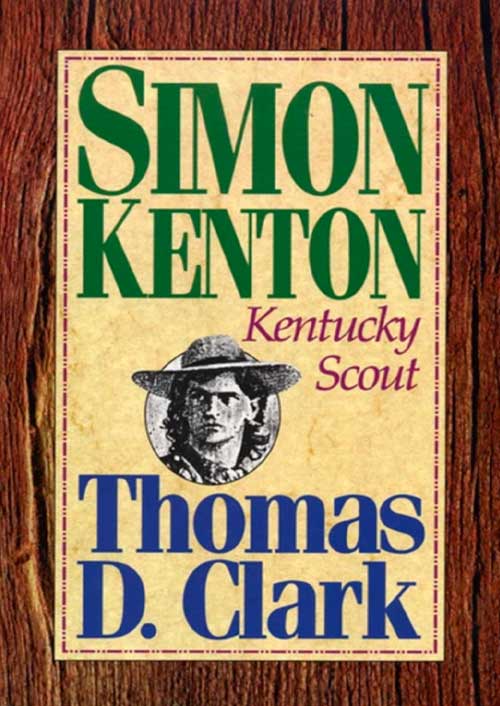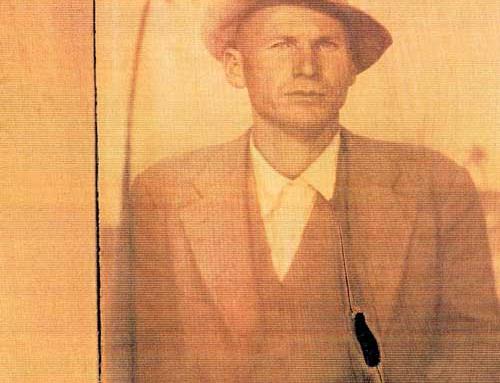Adventure story, biography, western, history, “Simon Kenton, Kentucky Scout” fits all these descriptions. Its vivid, intense language tells the story of Kentucky’s exploration and settlement through the life of the young frontiersman.
Kenton was born April 3, 1755, in Fauquier County, Virginia, the son of Mark and Mary (Miller) Kenton. He refused to attend school and remained illiterate all his life, learning only to sign his name.
 At age sixteen, he fought with William Leachman over a girl. He knocked Leachman unconscious and, believing he had killed him, ran away from home. Kenton assumed the name Simon Butler and worked his way to Pittsburgh, where he met adventurers who persuaded him to travel down the Ohio River in search of “cane-lands.”
At age sixteen, he fought with William Leachman over a girl. He knocked Leachman unconscious and, believing he had killed him, ran away from home. Kenton assumed the name Simon Butler and worked his way to Pittsburgh, where he met adventurers who persuaded him to travel down the Ohio River in search of “cane-lands.”
After several attempts, he and Thomas Williams entered Limestone Creek (now the site of Maysville) in the spring of 1775 and went into the interior. There they found tall cane, cleared it, made a rough camp, and planted some corn, probably the first cultivated by white men north of the Kentucky River. Kenton and Williams are considered the first permanent settlers of Mason County. In the autumn, Kenton moved to Boonesborough.
For the next few years, Kenton traveled through Kentucky meeting fellow pioneers. In 1777 George Rogers Clark appointed him spy for defense of the frontier. Kenton is credited with saving the life of Boone during an Indian attack at Boonesborough.
His courageous rescue of Daniel Boone and his friendships with such colorful, diverse, and controversial characters as George Rogers Clark, Simon Girty, and Chief John Logan are surpassed in drama only by his daring theft of the Indian’s horses at Chillicothe and his subsequent capture and eventual escape.
While he was held captive, Kenton showed an almost superhuman stamina. He ran the dreaded gauntlet several times, and withstood beatings, broken bones, and other tortures. In retrospect, it seems only the hand of Providence could have provided the timely intervention of Simon Girty and John Logan which postponed his execution.
Even more extraordinary was the sudden rainstorm which drenched the fire when the flames were already shooting up to consume Simon, who was tied to the stake. The appearance of a French Canadian trader almost immediately thereafter, his success in persuading the Indians to allow the prisoner to be taken to the British for interrogation, and Kenton’s ability simply to walk away from Detroit and return to Kentucky are equally amazing.
In 1784 he built a station on Lawrence Creek in Mason County to which he welcomed incoming settlers. His first guests included the widow Dowden and her four daughters, one of whom, Martha, became his bride on February 15, 1787. They were the first to be married at his station. Four children were born prior to December 1796. As Kenton’s family grew, he built a brick house for them near his station.
He operated a store in Washington, near Maysville, and hired Israel Donalson, teacher, to keep his books. The new house caught fire, and Martha, who was pregnant with their fifth child, was burned and died of shock. Within fifteen months, Kenton married Elizabeth Jarboe, Martha’s first cousin. They had five children. In 1798 he moved to Ohio, where he spent his later years, often in poverty but still a traveler. He made four trips to Missouri, where he bought more land, visited Boone, and considered relocating to the new state.
Kenton managed his finances poorly, lost large acreages of land, and while on a visit to Washington, Kentucky, in 1820, was imprisoned for debt. As he was a popular figure, the jailer, Thomas Williams, allowed him considerable freedom, and the citizenry were incensed by his incarceration. Kenton was released from prison on December 17, 1821, after the Kentucky legislature repealed the Debtor’s Law.
Kenton died on April 29, 1836, near Zanesville, Ohio, and was buried there. In 1865 his remains were moved to Urbana, Ohio. In 1840 the Kentucky legislature created a new county out of the western half of Campbell County and named it in Kenton’s honor.
For more information about “Simon Kenton, Kentucky Scout” by the late Thomas D. Clark, contact the Jesse Stuart Foundation.
By James M. Gifford
JSF CEO & Senior Editor
Adventure story, biography, western, history, “Simon Kenton, Kentucky Scout” fits all these descriptions. Its vivid, intense language tells the story of Kentucky’s exploration and settlement through the life of the young frontiersman.
Kenton was born April 3, 1755, in Fauquier County, Virginia, the son of Mark and Mary (Miller) Kenton. He refused to attend school and remained illiterate all his life, learning only to sign his name.
At age sixteen, he fought with William Leachman over a girl. He knocked Leachman unconscious and, believing he had killed him, ran away from home. Kenton assumed the name Simon Butler and worked his way to Pittsburgh, where he met adventurers who persuaded him to travel down the Ohio River in search of “cane-lands.”
After several attempts, he and Thomas Williams entered Limestone Creek (now the site of Maysville) in the spring of 1775 and went into the interior. There they found tall cane, cleared it, made a rough camp, and planted some corn, probably the first cultivated by white men north of the Kentucky River. Kenton and Williams are considered the first permanent settlers of Mason County. In the autumn, Kenton moved to Boonesborough.

For the next few years, Kenton traveled through Kentucky meeting fellow pioneers. In 1777 George Rogers Clark appointed him spy for defense of the frontier. Kenton is credited with saving the life of Boone during an Indian attack at Boonesborough.
His courageous rescue of Daniel Boone and his friendships with such colorful, diverse, and controversial characters as George Rogers Clark, Simon Girty, and Chief John Logan are surpassed in drama only by his daring theft of the Indian’s horses at Chillicothe and his subsequent capture and eventual escape.
While he was held captive, Kenton showed an almost superhuman stamina. He ran the dreaded gauntlet several times, and withstood beatings, broken bones, and other tortures. In retrospect, it seems only the hand of Providence could have provided the timely intervention of Simon Girty and John Logan which postponed his execution.
Even more extraordinary was the sudden rainstorm which drenched the fire when the flames were already shooting up to consume Simon, who was tied to the stake. The appearance of a French Canadian trader almost immediately thereafter, his success in persuading the Indians to allow the prisoner to be taken to the British for interrogation, and Kenton’s ability simply to walk away from Detroit and return to Kentucky are equally amazing.
In 1784 he built a station on Lawrence Creek in Mason County to which he welcomed incoming settlers. His first guests included the widow Dowden and her four daughters, one of whom, Martha, became his bride on February 15, 1787. They were the first to be married at his station. Four children were born prior to December 1796. As Kenton’s family grew, he built a brick house for them near his station.
He operated a store in Washington, near Maysville, and hired Israel Donalson, teacher, to keep his books. The new house caught fire, and Martha, who was pregnant with their fifth child, was burned and died of shock. Within fifteen months, Kenton married Elizabeth Jarboe, Martha’s first cousin. They had five children. In 1798 he moved to Ohio, where he spent his later years, often in poverty but still a traveler. He made four trips to Missouri, where he bought more land, visited Boone, and considered relocating to the new state.
Kenton managed his finances poorly, lost large acreages of land, and while on a visit to Washington, Kentucky, in 1820, was imprisoned for debt. As he was a popular figure, the jailer, Thomas Williams, allowed him considerable freedom, and the citizenry were incensed by his incarceration. Kenton was released from prison on December 17, 1821, after the Kentucky legislature repealed the Debtor’s Law.
Kenton died on April 29, 1836, near Zanesville, Ohio, and was buried there. In 1865 his remains were moved to Urbana, Ohio. In 1840 the Kentucky legislature created a new county out of the western half of Campbell County and named it in Kenton’s honor.
For more information about “Simon Kenton, Kentucky Scout” by the late Thomas D. Clark, contact the Jesse Stuart Foundation.
By James M. Gifford
JSF CEO & Senior Editor



